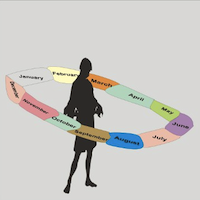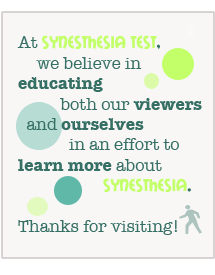Investigating Spatial Sequence Synesthesia
 Do you visualize numerical sequences in physical space? How ’bout days of the week, months in the year, or years in the past decade? If Wednesday’s floating to your left, and 1999 is situated just above your head, you may be experiencing spatial sequence synesthesia. Since several readers have inquired about this form, I thought it appropriate for a post topic. As far as tests go, there isn’t a whole lot to discuss. This form is relatively self-explanatory. Perhaps some of you, though, who’ve had similar experiences, mightn’t have thought them to be synesthetic. Let’s dive a little deeper!
Do you visualize numerical sequences in physical space? How ’bout days of the week, months in the year, or years in the past decade? If Wednesday’s floating to your left, and 1999 is situated just above your head, you may be experiencing spatial sequence synesthesia. Since several readers have inquired about this form, I thought it appropriate for a post topic. As far as tests go, there isn’t a whole lot to discuss. This form is relatively self-explanatory. Perhaps some of you, though, who’ve had similar experiences, mightn’t have thought them to be synesthetic. Let’s dive a little deeper!
Sequences in Physical Space
When we talk about visualizing sequences in physical space, we’re not talking about outer space. If you can see that far, you’re dealing with something far more esoteric and mystifying than synesthesia. In fact, we’re talking about the space around you – your “bubble”, if you will. If – when it comes to numbers, dates, and sequences – you visualize entities in your immediate vicinity, there’s a fair chance that you’re familiar with this type.
Spatial sequence synesthetes might have a tough time convincing their friends and family members that they’re seeing what they claim to be seeing. However, Dr. David Eagleman has no trouble believing in this phenomenon; after all, he is a neuroscientist (working at the Baylor College of Medicine, no less). Appropriately enough, Dr. Eagleman’s lab has actually developed a sort of virtual reality, in which synesthetes can map their spatial visualizations. The findings are quite interesting; you can get a quick briefing by reading his abstract. There are several takeaways, of course. What I find most compelling (and in hindsight intuitive) is that the research supported “the possibility that SSS is directly related to the sequence representations in nonsynesthetes” (Eagleman, 2009). Month visualizations, for instance, were generally mapped from left to right, which is consistent with the “directional bias” of Western speakers.
A Memory Advantage?
One study, conducted by Julia Simner of the University of Edinburgh in the UK, found that spatial sequence synesthetes have a built-in and automatic mnemonic reference. In other words, where the nonsynesthete needs to create a mnemonic device to remember a sequence (like “Please excuse my dear Aunt Sally.”), the synesthete can simply reference their spatial visualizations. Read the full coverage of this study on ScienceMag.org. It’s worth the five minutes it takes to peruse. So, really, there is a subtle memory advantage. It isn’t eidetic (or photographic), though.
This is certainly one of the most interesting forms of synesthesia that I’ve written on, and I’d love to learn more. Feel free to share your experiences anonymously, if you’d like! I’ve been tossing around the idea of publishing a collection of anonymous synesthetic experiences, with the thought that it might be beneficial for others to reference. Of course, all experiences published would be with the permission of the sharer, and (as I mentioned) each synesthetic experience would be published anonymously. Do share your thoughts on this, loyal readers!
That’s all for now, though! Whether tomorrow’s on your left or on your right, make it a fabulous day!
Credit for this image goes to People.Brunel.Ac.Uk




